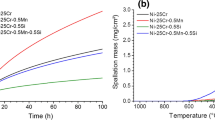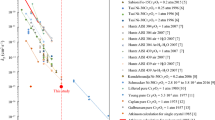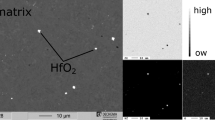Abstract
Oxidation of chromia-forming alloys (pure chromium, nickel–chromium alloy and ferritic stainless steel alloy) at temperature ranging from 800 to 1050 °C was conducted on samples with or without gold markers applied prior to testing. Gold is often used as a marker in order to identify oxide growth direction. Its localization inside the oxide scale can demonstrate an inward or an outward growth. It is found that gold particles can be found either at the internal metal/oxide interface or inside the scale or again at the external oxide/gas interface on the same sample (on NiCr and stainless steel alloys). For pure chromium oxidation, gold is found inside the chromia scale, at the equiaxed-columnar interface, as expected from ASTAR-TEM characterization. However, photoelectrochemical characterization has shown that gold can modify the semiconducting chromia properties. Finally, gold is not inert in these several conditions and should not be considered in these present cases, but also more generally in most cases, as an appropriate marker. On the contrary, ASTAR maps may permit to access the oxide growth direction without interfering the studied system.








Similar content being viewed by others
References
W. J. Quadakkers, A. Elschner, and W. Speier, H. Nickel, Applied Surface Science 52, (4), 271–287 (1991).
S. Chevalier, G. Bonnet, G. Borchardt, J.-C. Colson, and J.-P. Larpin, Ceramics 61, 177–187 (2000).
J. Pfeil, J. Iron Steel Inst. 119, 501–547 (1929).
P. Sarrazin, A. Galerie, J. Fouletier, Mechanisms of High Temperature Corrosion (Trans Tech Publication edition, 2008).
D. Young, High Temperature and Corrosion of Metals, ed. (2008).
H. Sieber, D. Hesse, X. Pan, S. Senz, and J. Heydenreich, J. Inorg. And Gal. Chem. 622, 1658–1666 (1996).
X. Ledoux, S. Mathieu, M. Vilasi, Y. Wouters, P. Del-Gallo, and M. Wagner, Oxid. Met. 80, 25–35 (2013).
Q. Dong, G. Hultquist, G. I. Sproule, and M. J. Graham, Corros. Sci. 49, 3348–3360 (2007).
L. Latu-Romain, Y. Parsa, S. Mathieu, M. Vilasi, A. Galerie, and Y. Wouters, Corros. Sci. 126, 238–246 (2017).
Y. Parsa, L. Latu-Romain, Y. Wouters, S. Mathieu, T. Perez, and M. Vilasi, Corros. Sci. 141, 46–52 (2018).
T. Perez, J. Ghanbaja, S. Mathieu, L. Latu-Romain, M. Vilasi, and Y. Wouters, Scripta Mater. 178, 176–180 (2020).
L. Latu-Romain, Y. Parsa, S. Mathieu, M. Vilasi, and Y. Wouters, Oxid. Met. 90, (3–4), 255–266 (2018).
L. Latu-Romain, Y. Parsa, S. Mathieu, M. Vilasi, and Y. Wouters, Oxid. Met. 90, (3–4), 267–277 (2018).
E. Rauch and M. Véron, Automated crystal orientation and phase mapping in TEM. Mater. Charact. 98, 1–9 (2014).
L. Latu-Romain, Y. Parsa, S. Mathieu, M. Vilasi, M. Ollivier, A. Galerie, and Y. Wouters, Oxid. Met. 86, (5), 497–509 (2016).
Z. Wu, J. Deng, S. Xie, H. Yang, X. Zhao, K. Zhang, H. Lin, H. Dai, and G. Guo, Microporous and Mesoporous Materials 224, 311–322 (2016).
M. Eichelbaum, K. Rademann, R. Müller, M. Radtke, H. Riesemeier, and W. Görner, Angew Chem. Int. 44, 7905–7909 (2005).
G. Mie, Annalen der Physik 25, 377 (1908).
K. L. Kelly, E. Coronado, L. L. Zhao, and G. C. Schatz, J. Phys. Chem. B 107, 668 (2003).
P. K. Jain, I. H. El-Sayed, and M. A. El-Sayed, Nanotoday 2, 18 (2007).
W.A. Weyl, Coloured Glasses (The Society of Glass Technology, 1951).
J. Zurek, D. J. Young, E. Essuman, M. Hänsel, H. J. Penkalla, L. Niewolak, and W. J. Quadakkers, Materials Science and Engineering A 477, 259–270 (2008).
D. Nguyen, J. Zhang, and D. J. Young, Corros. Sci. 112, 110–127 (2016).
M. R. Ardigo-Besnard, I. Popa, O. Heintz, R. Chassagnon, M. Vilasi, F. Herbst, P. Girardon, and S. Chevalier, Applied Surface Science 412, 196–206 (2017).
T. Roy, L. Latu-Romain, I. Guillotte, B. Latouche, Y. Wouters, Oxid. Met., to be published.
R. Prescott and M. J. Graham, Oxid. Met. 38, (3/4), 1992 (233–254).
E. W. A. Young, H. E. Bishop, and J. H. W. De Wit, Surf. Interface Anal. 9, 163–168 (1986).
F. Czerwinski, Acta Materialia 48, (3), 721–733 (2000).
Acknowledgements
This work is supported by the French National Research Agency (ANR) through the PSEUDO project. The authors acknowledge the facilities, and the scientific and technical assistance of the CMTC characterization platform of Grenoble INP supported by the Centre of Excellence of Multifunctional Architectured Materials "CEMAM" n°AN-10-LABX-44-01 funded by the "Investments for the Future" Program. The authors would like also to thank Florence Robaut for FIB-SEM preparation and Gilles Renou for TEM microscopy.
Author information
Authors and Affiliations
Corresponding author
Additional information
Publisher's Note
Springer Nature remains neutral with regard to jurisdictional claims in published maps and institutional affiliations.
Rights and permissions
About this article
Cite this article
Latu-Romain, L., Roy, T., Perez, T. et al. Should Gold Marker or TEM-ASTAR Characterization Be Used to Determine Oxide Growth Direction?. Oxid Met 96, 201–211 (2021). https://doi.org/10.1007/s11085-021-10042-x
Received:
Revised:
Accepted:
Published:
Issue Date:
DOI: https://doi.org/10.1007/s11085-021-10042-x




